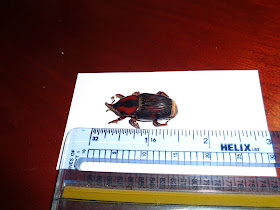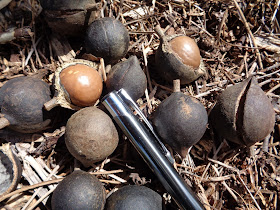Some fruits are either feast or famine and the star fruit is
one of those wonders. This fall, not only was our starfruit at the East
Port Environmental Campus Demonstration Garden producing, several Master
Gardeners were also bringing in bags of extra fruit to share – nice!
Whether you call it carambola, star fruit or five-finger, the fruit tree known
scientifically as Averrhoa carambola is exotic, tasty, and makes a nice
ornamental yard tree. Why not try this tree fruit in your own back yard?
First, let me quote word for word from our UF/IFAS
publication, "People who have been diagnosed with kidney disease should
not eat carambola (star fruit) unless their doctor says it is safe for them to
eat. This fruit may contain enough oxalic acid to cause a rapid decline in
renal function." Please keep this important warning in mind.
Originally from Southeast Asia, the carambola has been grown in Florida for
over one hundred years and is commercially produced in Dade, Lee, Broward, and
Palm Beach counties. This fruit is commonly seen in produce departments in most
grocery stores and is familiar to almost everyone. The carambola tree is small
to medium in size, evergreen to semi-evergreen depending on winter temperatures
and may have a single or multiple trunks. The small, but colorful pink to
lavender flowers are about three-eighths of an inch long. The flowers are
followed by a fleshy waxy berry from two to six-inches long with five lobbed
ribs that appear star-shaped when cut in cross-section. It takes about seventy-five
days from the time the fruit sets until it is ready to pick. There are also
about twelve edible seeds per fruit. Carambolas really appreciate being
protected from windy sites. As a matter of fact, wind damaged trees will show
browning or distorted leaves, some stem dieback, fruit damage and general
stunted growth. Keeping carambola trees pruned to about twelve feet tall will
also help increase hurricane resistance. Select a site to plant your carambola
that is in full sun, out of the wind and is well drained. If necessary, plant
the tree on a mound of soil to raise it up above areas that sometimes flood.
Build the mound three to four foot high and four to ten feet wide using native
soil. Carambolas are not tolerant of salty conditions and also may show
nutrient deficiencies in high pH soils. As the tree matures, it tolerance to
cold and freezing will improve. Generally, at temperatures of twenty to
twenty-four degrees Fahrenheit, large branches and even mature trees may die.
Accordingly, some protection may be necessary during the coldest of our winter
weather.
Carambola normally have two major crops per year ready from
August through September and from December through February. There will also be
scattered smaller crops. A five year old tree can produce up to one hundred
pounds per tree. Mature trees can eventually supply you with over two-hundred
and fifty pounds a year. It is no wonder why carambola tree owners are always
giving fruit away to friends and neighbors! A complete fertilizer suitable for
tropical fruits used as per label directions will keep the tree productive and
healthy. In addition, foliar applications of micronutrients may be needed to
ward off deficiencies. Variety selection is as much an issue of what is
available in the local garden centers, and what your personal tastes are.
Carambolas are either sweet or tart - some tart varieties will even sweeten up
if left on the tree to ripen further. ‘Arkin’ is a cultivar that originated in
Florida, has a sweet flavor and is very well suited for backyard production.
‘Lara’ is another variety from Florida that is also sometimes available. ‘Fwang Tung’ is
also recommended.
Local box store garden centers and specialty nurseries regularly
carry carambola. Carambola is a great dooryard fruit tree that is easy to
grow and produces an abundance of tasty fruit. Perhaps give one as a gift
to someone this Holiday Season! For more information on all types of fruit to
grow in our area, please call our Master Gardener volunteers on the Plant
Lifeline on Mondays, Wednesdays and Fridays from 1 to 4 pm at 764-4340 for
gardening help and insight into their role as an Extension volunteer.
Don't forget to visit our other County Plant Clinics in the area. Please
check this link for a complete list of site locations, dates and times - http://charlotte.ifas.ufl.edu/horticulture/Plant%20Clinics%20Schedule.pdf.
Resource: Crane, J. H. (2013)
Carambola Growing in the Florida Home Landscape. The University of Florida
Extension Service, IFAS.







